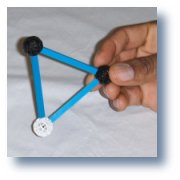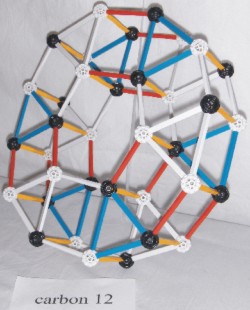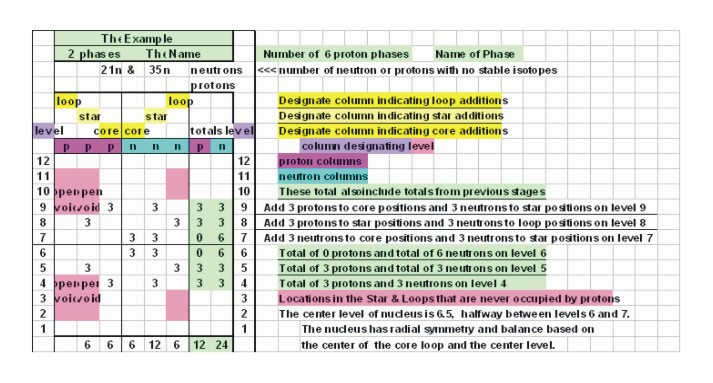
Definitions
for this Models
|
Color confinement holds the quarks together as protons and neutron while the electromagnetic force arranges those protons and neutrons into a hexagonal lattice like structure. The hexagonal nuclear structure is the result of triangles formed by the three quarks that comprise the protons and neutrons.
These are all nuclear structural components resulting from the lattice structure that is built around the interactions of the electromagnetic fields associated with the up and down quarks. All nuclear structures revolves around protons and neutrons that are ultimately built around electromagnetic interaction of the foundation particles, quarks, and their locations in the protons and neutrons. The model presented here is a lattice structure based on the interrelationship of electric and magnetic fields of the quarks that make up the protons and neutrons. The models shown here is constructed using struts and nodes obtained from ZOME.
The foundation particles are quarks that are represented in the models show here by �ZOME� nodes. |
|
 |
The black �ZOME� nodes represent �UP� quarks. |
 |
The white �ZOME� nodes represent �DOWN� quarks. |
|
The protons and neutrons are the primary components of the nucleus and both nucleons are composed of three quarks. |
|
|
The first nuclear components, protons and neutrons, are represented in the �ZOME� model by: |
|
 |
ProtonsThree blue struts connect black and white nodes to represent protons. The proton is shown as a �ZOME� construct using three blue struts (representing the color force) to connect two black nodes (representing the UP quarks) and a white node (representing the DOWN quark). The proton with 2 "UP" quarks (+4/3) and 1 "DOWN" quark (-1/3) equals an over all +1 charge for the proton. |
 |
NeutronsThree white struts connect white and black nodes to represent neutrons. The neutron is shown as a �ZOME� construct using three white struts (representing the color force) to connect two white nodes (representing the DOWN quarks) and a black node (representing the UP quark). The neutron with 2 "DOWN" quarks (-2/3) and 1 "UP" quark (+2/3) equals an over all zero charge for the neutron. |
 |
ALPHA ParticleThe alpha particle is made from two protons and two neutrons white nodes reresent down quarks and black nodes represent up quarks blue struts for protons and white struts for neutrons. |
 |
The Carbon 12 RingThe Carbon12 Ring is made from 3 alpha particles composed of 6 protons and 6 neutrons white nodes reresent down quarks and black nodes represent up quarks blue struts for protons and white struts for neutrons. |
|
In this and all subsequent segments the nucleus is studied and understood by examining �The Nuclear Valley of Stability� and how it progresses from one stable nucleus to the next via increasing �A� numbers. By determining how the next proton or neutron is added to form the next stable nucleus along the path of stable nuclei via ever larger �A� numbers it becomes apparent why that stability valley exists including why and how the nuclear lattice structure forms. Running along the bottom of this stable valley is a path of stability that demonstrates the apparent growth of the nucleus in an obvious and logical manner. This growth might be compared to growing a crystal one particle at a time This explanation does not represent the path of nuclear fusion that occurs within stars but rather it is meant to demonstrate why the �Valley of Stable Nucleus� exits. Following the nuclei along the path of stability, approximatly ten phases of the nuclear structure become evident. For the purpose of this paper they are identified as:
The meaning of these identifications will become evident as you follow through this treatise of the lattice structure of the nucleus.  The first step as we have already explained is building the nuclear core. The steps to that point are well known but the resulting structure is developed next. |
|